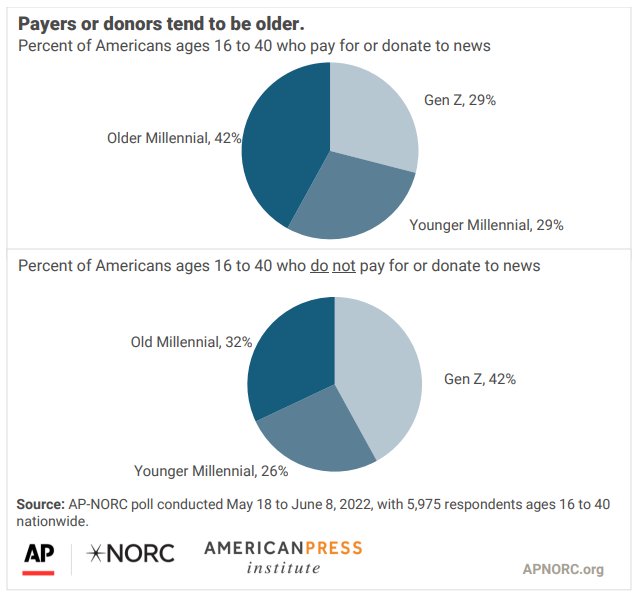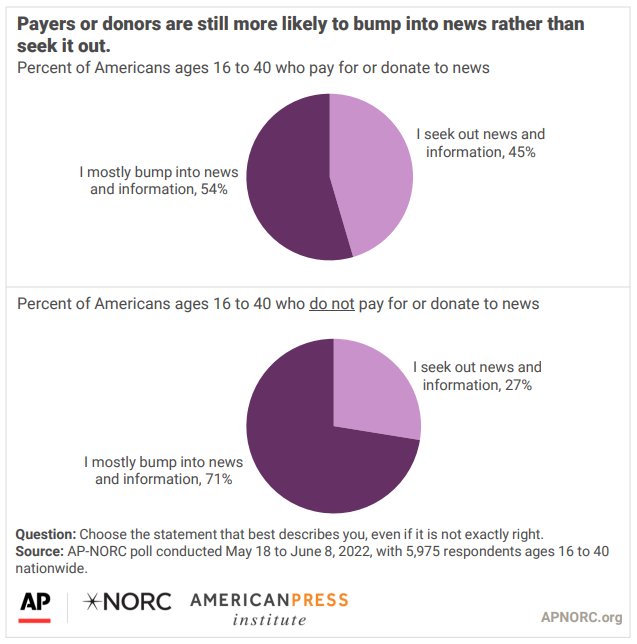Sixty percent of 16- to 40-year-olds, regardless of race and ethnicity, pay for or donate to news in some way, including 51% of Gen Z, 63% of young Millennials, and 67% of older Millennials, according to a new study from the Media Insight Project, a collaboration between the American Press Institute and The Associated Press-NORC Center for Public Affairs Research.
With this study, the Media Insight Project addresses one of the crucial questions about the future of journalism: how can news media create content that Gen Z and Millennial consumers are willing to pay for or donate to directly? The report highlights how these new generations have turned their attention to formats from independent news creators such as video, audio, podcasts, and newsletters as news sources.
“It is crucial for news organizations and independent news creators to know how Gen Z and Millennials consume and, more importantly, pay for or donate to news,” said Michael D. Bolden, CEO and executive director of the American Press Institute. “The study highlights the importance of diverse communication and subscription strategies that cultivate relationships with Millennial and Gen Z audiences. This is an important shift in media that healthy news organizations need to develop and sustain as part of their long-term strategies.”
This study dives deeply into the data and expands on findings released in the previous reports: “Fatigue, traditionalism, and engagement: News habits and attitudes of the Gen Z and Millennial generations” and “Knowing the news: How Gen Z and Millennials get information on essential topics,” based on a survey of 5,975 Americans ages 16 to 40.
The report outlines key behavioral and demographic characteristics among those who pay for or donate to news and those who do not. It explores how Gen Z and Millennials who pay for or donate to two different sources of news: digital or print newspapers and content from independent creators including email newsletters, video, or audio — a source popular among these audiences.
The study defines those who pay for or donate to news as those who report either personally paying for or donating to either print or digital magazines, print or digital newspapers, digital news apps, nonprofit news sites, email newsletters from independent creators, video or audio content from independent creators or influencers through YouTube or podcasts, public radio, or TV.
“While the study highlights how news payers and donors tend to be more engaged and connected, it also points out how news organizations and independent creators could attract wider audiences and increase their revenue,” said David Sterrett, senior research scientist with The AP-NORC Center. “Understanding what makes Gen Z and Millennials give money to news and what makes these consumers unique is crucial for news organizations to adapt and thrive in today’s competitive media landscape.”
Key findings include:

Key takeaways for news media:

About the report:
This survey was conducted by the Media Insight Project, an initiative of the American Press Institute (API) and The Associated Press-NORC Center for Public Affairs Research. The survey was funded by API. Staff from API, NORC at the University of Chicago, and AP collaborated on all aspects of the study.
Data were collected using both probability and non-probability sample sources. Interviews for this survey were conducted from May 18 through June 8, 2022, with people ages 16 to 40 representing the 50 states and the District of Columbia.
The probability sample source is the AmeriSpeak® Panel, NORC’s probability-based panel designed to be representative of the U.S. household population. The non-probability sample was provided by Cint based on quotas related to age, race and ethnicity, gender, and education.
The overall margin of error for the combined sample is +/- 1.7 percentage points at the 95 percent confidence level, including the design effect. The margin of sampling error may be higher for subgroups.
Sampling error is only one of many potential sources of error and there may be other unmeasured errors in this or any other survey.
Complete questions and results are available at www.mediainsight.org.
Details about the Media Insight Project can be found at: www.mediainsight.org.
A full description of the study methodology for the surveys can be found at the end of the report.
The proper description of the survey’s authorship is as follows: This study was conducted jointly by the American Press Institute and The Associated Press-NORC Center for Public Affairs Research.
About the Media Insight Project:
The Media Insight Project is a collaboration between the American Press Institute and The AP-NORC Center for Public Affairs Research with the objective of conducting high-quality, innovative research meant to inform the news industry and the public about various important issues facing journalism and the news business. The Media Insight Project brings together the expertise of both organizations and their respective partners, and involves collaborations among key staff at the American Press Institute, NORC at the University of Chicago, and The Associated Press.
About the American Press Institute:
The American Press Institute advances an innovative and sustainable news industry by helping publishers understand and engage audiences, grow revenue, improve public-service journalism, and succeed at organizational change. We believe that for democracies to thrive, people need accurate news and information about their communities, the problems of civil society and the debates over how to solve them. That requires an economically sustainable free press that reflects the diversity of American society and understands the needs of its communities. API is a national 501(c)3 nonprofit educational organization affiliated with the News Media Alliance.
About the Associated Press-NORC Center for Public Affairs Research:
The AP-NORC Center for Public Affairs Research taps into the power of social science research and the highest-quality journalism to bring key information to people across the nation and throughout the world.
The two organizations have established The AP-NORC Center for Public Affairs Research to conduct, analyze, and distribute social science research in the public interest on newsworthy topics, and to use the power of journalism to tell the stories that research reveals. Learn more at www.apnorc.org
Comments
No comments on this item Please log in to comment by clicking here